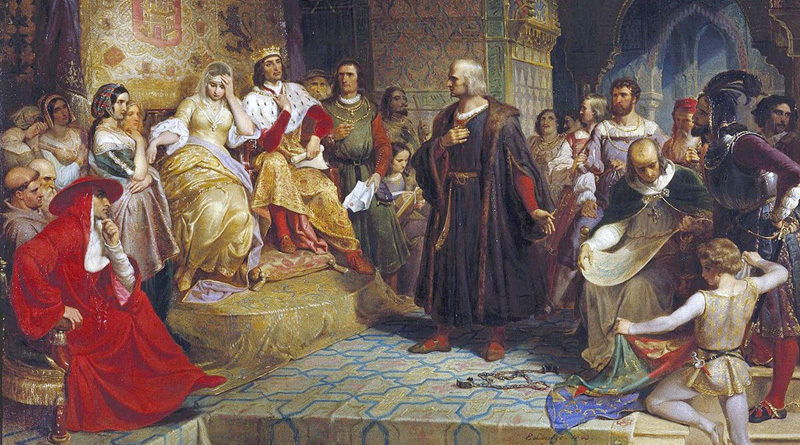Columbus Did Nothing Wrong, The Geneva Convention Says So!
By James Fulford
I’ve been writing VDARE.com’s Columbus Day round ups since 2008. Normally not much happens in the Columbus line between one Columbus Day and another.
This year’s Columbus Day, October 12, is different. This year Columbus has been part of the same anti-white Monumental Destruction that’s been going on as a result of the George Floyd Hoax. You see, Columbus is a dead white male, and that makes whatever he did bad.
The great Patrick J. Buchanan has written about it here:
In Boston, the Columbus statue was beheaded.
And here
That statue stood next to the Baltimore neighborhood of Little Italy and had been dedicated in 1984 by President Ronald Reagan.
In Chicago, mostly black rioters tried and failed to topple a Columbus statue…which was then removed for them by the Chicago authorities [Christopher Columbus statue removed in Chicago following protests, Guardian, July 24, 2020]
Extremely significant point: If the USA had been conquered and occupied by a hostile power, the Geneva Convention would forbid the destruction of its monuments.
On the 400th anniversary of Columbus‘s voyage of discovery, October 12, 1892, Chauncey Depew, a famous lawyer, statesman and public speaker, made a speech that became known as the “Columbian Oration” at the Columbian Exposition in Chicago, which was itself a celebration of Columbus.
All hail, Columbus, discoverer, dreamer, hero, and apostle. We here, of every race and country, recognize the horizon which bounded his vision and the infinite scope of his genius. The voice of gratitude and praise for all the blessings which have been showered upon mankind by his adventure is limited to no language but is uttered in every tongue. Neither marble nor brass can fitly form his statue. Continents are his monument, and unnumbered millions, present and to come, who enjoy in their liberties and happiness the fruits of his faith, will reverently guard and preserve, from century to century, his name and fame. [More]
There’s 5000 words omitted there, but Depew’s point is that Columbus’s discovery of America was good thing not only for America, but for the world.
He declared Christianity good, civilization good, settlement good, religious liberty good, and—by implication of course—pre-Columbian savagery bad.
By 1992, the 500th anniversary “anti-racism“ was already a Thing, and Columbus was the villain who had brought whiteness to the North and South American continents:
To highlight the achievements of pre-Columbian cultures, indigenous peoples from around the Americas converged today near Mexico City at the great Pyramids of the Sun and the Moon. At this Aztec monument, they erected steam lodges, smoked peace pipes and chanted Indian prayers.
Indians In Protest Against Columbus, by James Brooke, NYT, October 13, 1992
The indigenous peoples from north of the border were in Mexico because that’s the farthest north pre-Columbian civilization, as represented by cities and stone temples, got.
The steam lodges, peace pipes, and so on, are not the customs of the Aztecs, but of North American Indians. However, since the customs of the Aztecs included slavery, mass human sacrifice, and cannibalism on an industrial scale, that’s understandable.
I supposed most Woke haters of whiteness don’t know anything about the cannibalism, because it’s not taught in schools, which insist on telling the boring parts of history and leaving out the interesting ones. G. K. Chesterton wrote about this in 1925:
Chesterton goes on:
The Everlasting Man, Part One, Chapter 6, 1925
The online Britannica defines the “Columbian Exchange” as:
Europe got potatoes, tobacco, turkeys and beaver pelts in this exchange. Indians got, much against their will, civilization. And the Historic American Nation got a place to be born.
This is what Chauncey Depew, speaking 80 years earlier, meant when said of Columbus “Continents are his monument.”
A white St. John’s University teacher in Maryland may lose his job for explaining this:
For helping his students think critically about the tradeoffs in the “Columbian Exchange,” Richard Taylor has been deemed to violate St. John’s University’s “Bias, Discrimination, and Harassment” policy.
The adjunct professor of history, a Marine Corps reserveman and former New York City cop, will learn his fate in a meeting with interim Dean Gina Florio on Friday, according to the Foundation for Individual Rights in Education.
Professor found guilty of harassment for asking students if global trade has been good overall, by Greg Piper, The College Fix, October 8, 2020
Apparently what triggered the students was a reference to slavery. Slavery was part of the “Exchange” because there was trade in slaves by Columbus himself, and later the African Slave Trade that you’ve heard so much about.
Taylor put this down as a negative, obviously, but was attacked in class by students who felt, according to The College Fix, that “slavery could never be justified” when Taylor’s PowerPoint asked, in a final, “discussion prompt” slide “Do the positives justify the negatives?”
This was the student response, from an Instagram post by SJURadicals, September 10, 2020.
Of course, what none of the students seem to know is that there was slavery in America when there were only Indians there–they enslaved other Indians. There was slavery in Africa when there were only Africans there to enslave other Africans.
What white people’s navigational arts, starting with Columbus, added in the Columbian Exchange was freedom and Christianity, as Depew pointed out in 1892. We didn’t invent slavery, we invented ships, and freedom under law.
Pre-Columbian North America wasn’t even as civilized as the cannibal states of South America—it was what Thomas Hobbes famously described in Leviathan in 1651 as a “state of nature” in which
Columbus fought cannibals, and if he captured Indian slaves, he sent them to European masters who wouldn’t even think of eating them.
The Columbian Exchange was a net benefit for the Indians, for the world, and most of all, for the Historic American Nation.

